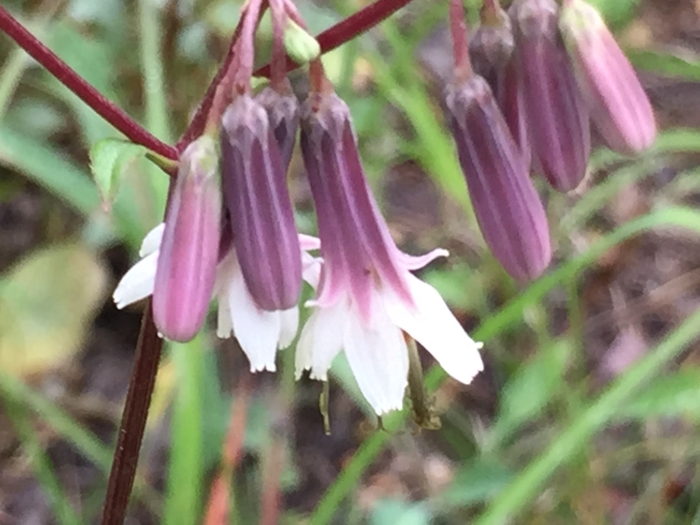White Rattlesnakeroot
(Nabalus albus)
White Rattlesnakeroot (Nabalus albus)
/
/

Mary Krieger
CC BY 4.0
Image By:
Mary Krieger
Recorded By:
Copyright:
CC BY 4.0
Copyright Notice:
Photo by: Mary Krieger | License Type: CC BY 4.0 | License URL: http://creativecommons.org/licenses/by/4.0/ | Rights Holder: Mary Krieger | Publisher: iNaturalist | Date Created: 2018-08-04T16:33:07Z |















































Estimated Native Range
Summary
Nabalus albus, commonly known as White Rattlesnakeroot, is a deciduous biennial or perennial herb native to rich, mesic woodlands and forest clearings in the Northeastern and Midwestern United States, as well as Ontario. It typically grows to a height of 2 to 6 feet (0.6 to 1.8 meters) with a spread of 1 to 3 feet (0.3 to 0.9 meters). The plant features basal and alternate leaves with the leaf blade length ranging between 40 and 300 mm. White Rattlesnakeroot is particularly noted for its unique inflorescence; the flower heads consist solely of ray flowers, each with a strap-shaped ray that may have small teeth at the tip. The flowers are usually white, but can vary in color from blue to purple, pink to red, and they bloom from July to September, adding a delicate texture to the garden.
White Rattlesnakeroot is valued for its tall, stately appearance and its ability to thrive in shady conditions, making it a suitable choice for woodland gardens and naturalized areas. It is also used in border plantings and as an accent in perennial beds. This plant prefers partial to full shade and consistently moist, well-drained soils, though it is tolerant of a range of soil types. It is relatively low maintenance, but may require staking in very rich soils or overly shaded conditions. While not commonly afflicted by serious pests or diseases, it can occasionally suffer from leaf spot. White Rattlesnakeroot is also appreciated for its medicinal properties, historically used by Native Americans to treat a variety of ailments.CC BY-SA 4.0
White Rattlesnakeroot is valued for its tall, stately appearance and its ability to thrive in shady conditions, making it a suitable choice for woodland gardens and naturalized areas. It is also used in border plantings and as an accent in perennial beds. This plant prefers partial to full shade and consistently moist, well-drained soils, though it is tolerant of a range of soil types. It is relatively low maintenance, but may require staking in very rich soils or overly shaded conditions. While not commonly afflicted by serious pests or diseases, it can occasionally suffer from leaf spot. White Rattlesnakeroot is also appreciated for its medicinal properties, historically used by Native Americans to treat a variety of ailments.CC BY-SA 4.0
Plant Description
- Plant Type: Herb
- Height: 2-5 feet
- Width: 1-2 feet
- Growth Rate: Moderate
- Flower Color: White
- Flowering Season: Summer, Fall
- Leaf Retention: Deciduous
Growth Requirements
- Sun: Full Sun, Part Shade
- Water: Medium
- Drainage: Slow, Medium, Fast
Common Uses
Bird Garden, Butterfly Garden, Edible*Disclaimer: Easyscape's listed plant edibility is for informational use. Always verify the safety and proper identification of any plant before consumption., Low Maintenance
Natural Habitat
Rich, mesic woodlands and forest clearings
Other Names
Common Names: Boott’s Rattlesnake-Root, White Lettuce, Prenanthe Blanche
Scientific Names: , Nabalus albus, Prenanthes alba, Nabalus suavis, Prenanthes alba subsp. alba, Prenanthes alba var. pallida, Prenanthes rubicunda, Chondrilla alba, Chondrilla rubicunda, Harpalyce alba
GBIF Accepted Name: Nabalus albus (L.) Hook.